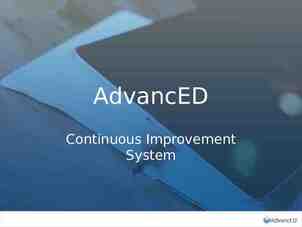Operating Systems Disk Scheduling A. Frank – P. Weisberg
27 Slides1.13 MB
Operating Systems Disk Scheduling A. Frank - P. Weisberg
Price per Megabyte of Magnetic Hard Disk, From 1981 to 2004 2 A. Frank - P. Weisberg
Moving-head Disk Mechanism 3 A. Frank - P. Weisberg
Elements of File Management 4 A. Frank - P. Weisberg
Disk Scheduling (1) The operating system is responsible for using hardware efficiently — for the disk drives, this means having a fast access time and disk bandwidth. Access time has two major components: – Seek time is the time for the disk are to move the heads to the cylinder containing the desired sector. – Rotational latency is the additional time waiting for the disk to rotate the desired sector to the disk head. 5 Minimize seek time seek distance. Disk bandwidth is the total number of bytes transferred, divided by the total time between the first request for service and the completion of last transfer. A. Frank - P. Weisberg
Components of Disk I/O Transfer 6 A. Frank - P. Weisberg
Disk Scheduling (2) There are many sources of disk I/O request: – OS – System processes – Users processes I/O request includes input/output mode, disk address, memory address, number of sectors to transfer. OS maintains queue of requests, per disk or device. Idle disk can immediately work on I/O request, busy disk means work must queue: 7 – Optimization algorithms only make sense when a queue exists.
Disk Structure Disk drives are addressed as large 1-dimensional arrays of logical blocks, where the logical block is the smallest unit of transfer. The 1-dimensional array of logical blocks is mapped into the sectors of the disk sequentially: – Sector 0 is the first sector of the first track on the outermost cylinder. – Mapping proceeds in order through that track, then the rest of the tracks in that cylinder, and then through the rest of the cylinders from outermost to innermost. 8 A. Frank - P. Weisberg
Disk Scheduling Algorithms Note that drive controllers have small buffers and can manage a queue of I/O requests (of varying “depth”). Several algorithms exist to schedule the servicing of disk I/O requests. The analysis is true for one or many platters. We illustrate them with a I/O request queue (cylinders are between 0-199): queue 98, 183, 37, 122, 14, 124, 65, 67 head starts at 53 9 A. Frank - P. Weisberg
First Come First Serve (FCFS) Example 10 Illustration shows total head movement of 640 cylinders. A. Frank - P. Weisberg
First Come First Serve (FCFS) Handle I/O requests sequentially. Fair to all processes. Approaches random scheduling in performance if there are many processes/requests. Suffers from global zigzag effect. 11 A. Frank - P. Weisberg
Shortest Seek Time First (SSTF) Example 12 Illustration shows total head movement of 236 cylinders. A. Frank - P. Weisberg
Shortest Seek Time First (SSTF) Selects the request with the minimum seek time from the current head position. Also called Shortest Seek Distance First (SSDF) – It’s easier to compute distances. It’s biased in favor of the middle cylinders requests. SSTF scheduling is a form of SJF scheduling; may cause starvation of some requests. 13 A. Frank - P. Weisberg
Elevator Algorithms Algorithms based on the common elevator principle. Four combinations of Elevator algorithms: .Service in both directions or in only one direction – .Go until last cylinder or until last I/O request – Go until Go until the Go until the last cylinder last request Direction Service both directions 14 Scan Service in only one directionA. FrankC-Scan - P. Weisberg Look C-Look
Scan Example 15 Illustration shows total head movement of 208 cylinders. A. Frank - P. Weisberg
Scan The disk arm starts at one end of the disk, and moves toward the other end, servicing requests until it gets to the other end of the disk, where the head movement is reversed and servicing continues. It moves in both directions until both ends. Tends to stay more at the ends so more fair to the extreme cylinder requests. 16 A. Frank - P. Weisberg
Look The disk arm starts at the first I/O request on the disk, and moves toward the last I/O request on the other end, servicing requests until it gets to the other extreme I/O request on the disk, where the head movement is reversed and servicing continues. It moves in both directions until both last I/O requests; more inclined to serve the middle cylinder requests. 17 A. Frank - P. Weisberg
C-Scan Example 18 A. Frank - P. Weisberg
C-Scan The head moves from one end of the disk to the other, servicing requests as it goes. When it reaches the other end, however, it immediately returns to the beginning of the disk, without servicing any requests on the return trip. Treats the cylinders as a circular list that wraps around from the last cylinder to the first one. Provides a more uniform wait time than SCAN; it treats all cylinders in the same manner. 19 A. Frank - P. Weisberg
C-Look Example 20 A. Frank - P. Weisberg
C-Look Look version of C-Scan. Arm only goes as far as the last request in each direction, then reverses direction immediately, without first going all the way to the end of the disk. In general, Circular versions are more fair but pay with a larger total seek time. Scan versions have a larger total seek time than the corresponding Look versions. 21 A. Frank - P. Weisberg
Another Example LOOK 22 A. Frank - P. Weisberg C-LOOK
Graphs for previous example LOOK 23 A. Frank - P. Weisberg C-LOOK
Other Disk Scheduling Policies Pickup – A combination of FCFS and Look. – Goes to next I/O request by FCFS but services all existing requests on the way to it. Priority – Goal is not to optimize disk use but to meet other objectives. – Short batch jobs may have higher priority. – Provide good interactive response time. 24 A. Frank - P. Weisberg
Scan Algorithm Variations FScan – Use two queues. – One queue is empty to receive new requests. N-step-Scan – Segments the disk request queue into subqueues of length N. – Subqueues are processed one at a time, using Scan. – New requests added to other queue when a certain queue is processed. 25 A. Frank - P. Weisberg
Selecting a Disk-Scheduling Algorithm (1) Performance depends on the number and types of requests. Requests for disk service can be influenced by the file-allocation method. The disk-scheduling algorithm should be written as a separate module of the operating system, allowing it to be replaced with a different algorithm if necessary. 26 A. Frank - P. Weisberg
Selecting a Disk-Scheduling Algorithm (2) With low load on the disk, It’s FCFS anyway. SSTF is common and has a natural appeal – good for medium disk load. SCAN and C-SCAN perform better for systems that place a heavy load on the disk; Less starvation. Performance depends on number and types of requests. Requests for disk service can be influenced by the fileallocation method and metadata layout. Either SSTF or LOOK (as part of an Elevator package) is a reasonable choice for the default algorithm. 27 A. Frank - P. Weisberg
































